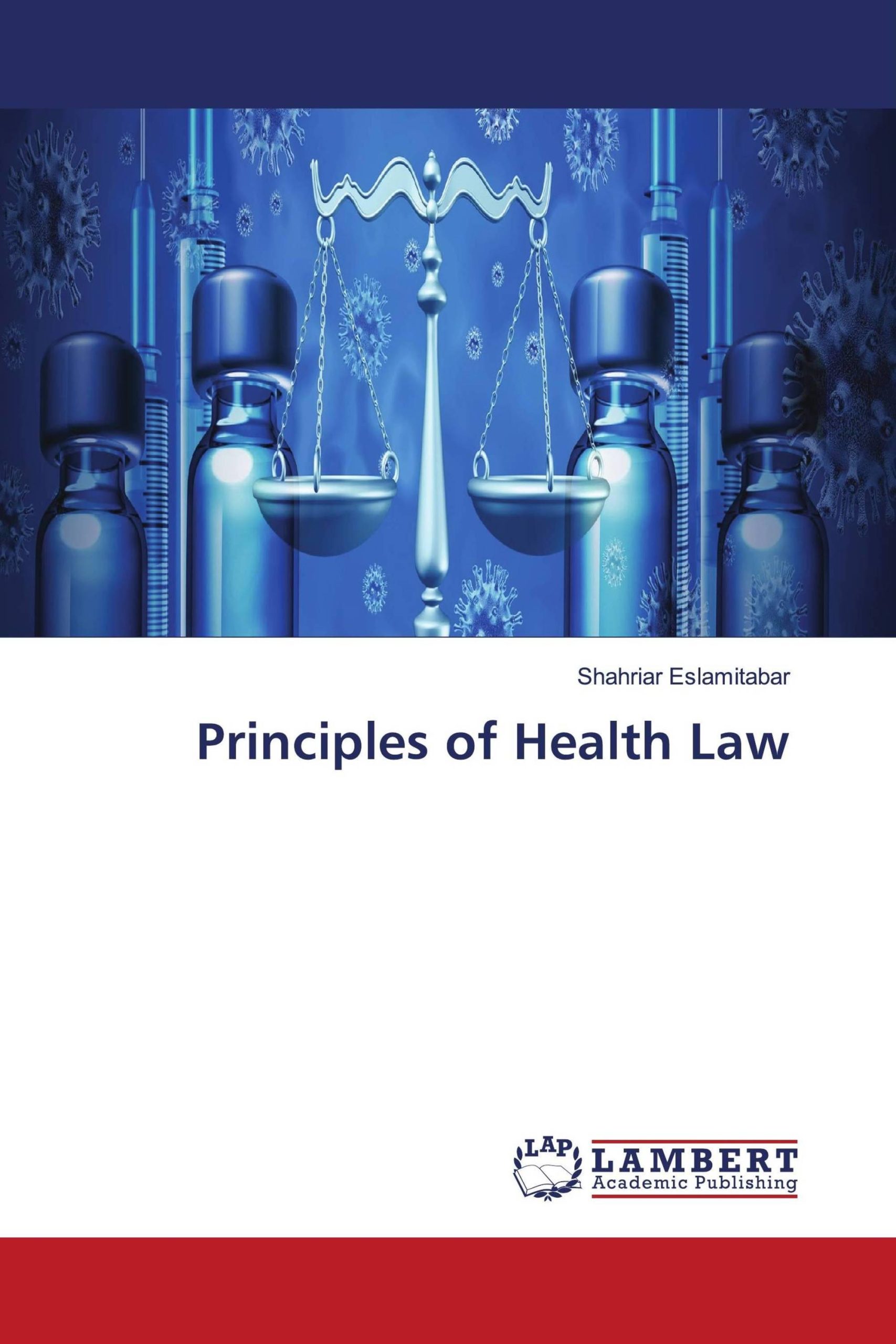کتاب Principles of Health Law
۵۹۲,۰۰۰ تومان Original price was: ۵۹۲,۰۰۰ تومان.۴۲۸,۶۰۸ تومانCurrent price is: ۴۲۸,۶۰۸ تومان.
| تعداد صفحات | 291 |
|---|---|
| شابک | 978-620-5-49505-6 |
| انتشارات |

کتاب Principles of Health Law – مروری جامع بر اصول حقوق سلامت
کتاب Principles of Health Law اثری است جامع و مفید که به بررسی قوانین و مقررات حاکم بر نظام سلامت میپردازد. این کتاب بهطور خاص برای دانشجویان، پژوهشگران و متخصصان حوزه حقوق سلامت طراحی شده و چالشهای قانونی، اخلاقی و اجتماعی این حوزه را مورد تحلیل قرار میدهد.
درباره کتاب Principles of Health Law
کتاب Principles of Health Law راهنمایی کامل برای درک اصول قانونی مرتبط با سیستمهای بهداشت و درمان است. نویسنده با نگاهی عمیق و ساختارمند، موضوعاتی چون حقوق بیماران، مسئولیتهای پزشکان و کادر درمان، مالکیت دادههای پزشکی، و نقش دولتها در ارائه خدمات سلامت را پوشش میدهد.
موضوعات کلیدی کتاب
- حقوق بیماران: بررسی حقوق و مسئولیتهای قانونی بیماران در نظام سلامت.
- مسئولیت حرفهای پزشکان: تحلیل جنبههای قانونی خطاهای پزشکی و مسئولیتهای حرفهای کادر درمان.
- اخلاق پزشکی: پرداختن به موضوعات اخلاقی در تصمیمگیریهای پزشکی.
- مالکیت دادهها: تحلیل چالشهای حقوقی پیرامون دادههای پزشکی و حریم خصوصی.
- سیاستگذاری در سلامت: نقش قوانین و مقررات در سیاستگذاری بهداشت عمومی.
ویژگیهای برجسته کتاب Principles of Health Law
- دیدگاه بینالمللی: بررسی تطبیقی قوانین سلامت در کشورهای مختلف.
- مطالعات موردی: ارائه مثالهای واقعی برای درک بهتر مفاهیم قانونی.
- رویکرد چندبعدی: تلفیق جنبههای حقوقی، اخلاقی و اجتماعی در تحلیل مسائل سلامت.
- ساده و کاربردی: مناسب برای خوانندگانی با دانش اولیه حقوق یا علوم پزشکی.
چرا کتاب Principles of Health Law را بخوانید؟
اگر در حوزه حقوق سلامت فعالیت میکنید یا به دنبال درکی عمیقتر از چالشهای قانونی و اخلاقی در نظامهای بهداشتی هستید، این کتاب مرجعی ارزشمند است. همچنین، مطالعه این اثر به شما کمک میکند تا با مسائل روز و پیشرفتهای قانونی در این زمینه آشنا شوید و از تجربیات علمی و عملی دیگر کشورها بهرهمند شوید.
مخاطبان کتاب Principles of Health Law
- دانشجویان حقوق و پزشکی: برای درک اصول و مقررات حاکم بر نظام سلامت.
- متخصصان و وکلای حوزه سلامت: بهعنوان مرجعی کاربردی برای فعالیتهای حرفهای.
- سیاستگذاران و مدیران بهداشتی: جهت استفاده از مبانی قانونی در تصمیمگیریهای کلان.
- پژوهشگران علوم اجتماعی و حقوقی: برای مطالعه تطبیقی قوانین و مقررات سلامت.
سفارش کتاب Principles of Health Law
برای خرید این کتاب و آشنایی بیشتر با اصول و قوانین حقوق سلامت، به بخش فروشگاه سایت ما مراجعه کنید یا با تیم پشتیبانی تماس بگیرید. این کتاب ابزار مفیدی برای افزایش دانش و تخصص در این حوزه مهم و حساس است.
1. حقوق چیست و چه تاریخی دارد؟ 🤔
پاسخ: حقوق به مجموعه قوانین و مقرراتی گفته میشود که توسط جامعه برای نظمدهی به روابط افراد و سازمانها ایجاد شده است. تاریخ حقوق به دوران باستان بازمیگردد و در طول تاریخ با تمدنهای مختلف تکامل یافته است.
2. تفاوت میان حقوق خصوصی و حقوق عمومی چیست؟ ⚖️
پاسخ: حقوق خصوصی به مسائلی که بین افراد و گروههای خصوصی مطرح میشود (مانند قراردادها و مالکیت) مربوط است، در حالی که حقوق عمومی به روابط میان دولت و شهروندان و مسائل مرتبط با دولتها و حقوق عمومی میپردازد.
3. حق سلامت چیست و چگونه تعریف میشود؟ 🏥
پاسخ: حق سلامت به معنای دسترسی به مراقبتهای بهداشتی و شرایط زیستی سالم برای تمام افراد است. این حق در اسناد بینالمللی نظیر اعلامیه جهانی حقوق بشر و میثاقهای اقتصادی، اجتماعی و فرهنگی مورد تأکید قرار گرفته است.
4. سندهای بینالمللی مرتبط با حقوق بشر و سلامت کدامند؟ 🌍
پاسخ: مهمترین اسناد بینالمللی شامل “اعلامیه جهانی حقوق بشر” (ماده 25) و “میثاق بینالمللی حقوق اقتصادی، اجتماعی و فرهنگی” است که به حقوق بهداشت و سلامت تأکید دارند.
5. حقوق سلامت عمومی چیست و چه ویژگیهایی دارد؟ 🏛️
پاسخ: حقوق سلامت عمومی شامل مجموعهای از اصول حقوقی است که در زمینه سلامت عمومی و رفاه اجتماعی تأکید دارد. این حقوق معمولاً به نقش دولت در تأمین و تنظیم سلامت عمومی و مقابله با بحرانهای بهداشتی مربوط میشود.
6. رابطه میان حقوق سلامت عمومی و اداری چیست؟ 📜
پاسخ: حقوق سلامت عمومی با حقوق اداری ارتباط نزدیکی دارد زیرا اغلب از طریق مقررات دولتی و ابزارهای اجرایی (مانند صدور مجوزها و بازرسیها) به اجرا درمیآید.
7. مبانی اخلاقی حاکم بر حقوق مراقبتهای بهداشتی کدامند؟ 💡
پاسخ: اصول اخلاقی که بر حقوق مراقبتهای بهداشتی حاکم است، شامل خودمختاری، فایدهرسانی، عدم آسیب و عدالت میشود.
8. آیا مسئولیتهای اخلاقی در مراقبتهای بهداشتی میتواند به مسئولیت قانونی منجر شود؟ ⚖️
پاسخ: بله، مسئولیتهای اخلاقی در مراقبتهای بهداشتی میتواند منجر به مسئولیت قانونی شود، به خصوص در صورتی که رفتارهای غیراخلاقی منجر به آسیب به بیمار گردد.
9. اخلاق زیستی چیست و چه تفاوتی با اخلاق عمومی دارد؟ 🌱
پاسخ: اخلاق زیستی به مسائل اخلاقی مرتبط با علم پزشکی و زیستشناسی میپردازد، در حالی که اخلاق عمومی ممکن است به مسائل اخلاقی گستردهتر مانند عدالت اجتماعی و حقوق بشر اشاره داشته باشد.
10. چگونه اصول اخلاقی در زمینههای مختلف پزشکی مانند آزمایشهای بالینی یا تولید مثل مصنوعی اعمال میشوند؟ 🧬
پاسخ: در زمینههایی مانند آزمایشهای بالینی و تولید مثل مصنوعی، اصولی همچون رضایت آگاهانه، عدم آسیب، و عدالت باید رعایت شود تا از حقوق بیماران و افراد تحت درمان محافظت گردد.
| تعداد صفحات | 291 |
|---|---|
| شابک | 978-620-5-49505-6 |
| انتشارات |
محصولات مشابه
-
کتاب The Grey Stories
۱۴۰,۰۰۰ تومانOriginal price was: ۱۴۰,۰۰۰ تومان.۱۰۳,۶۰۰ تومانCurrent price is: ۱۰۳,۶۰۰ تومان. -
کتاب Principles of Financial Management and Feasibility Studies
۲۴۲,۰۰۰ تومانOriginal price was: ۲۴۲,۰۰۰ تومان.۱۷۵,۲۰۸ تومانCurrent price is: ۱۷۵,۲۰۸ تومان. -
کتاب The Mystic Ladder
۳۲۸,۰۰۰ تومانOriginal price was: ۳۲۸,۰۰۰ تومان.۲۳۲,۲۲۴ تومانCurrent price is: ۲۳۲,۲۲۴ تومان.






